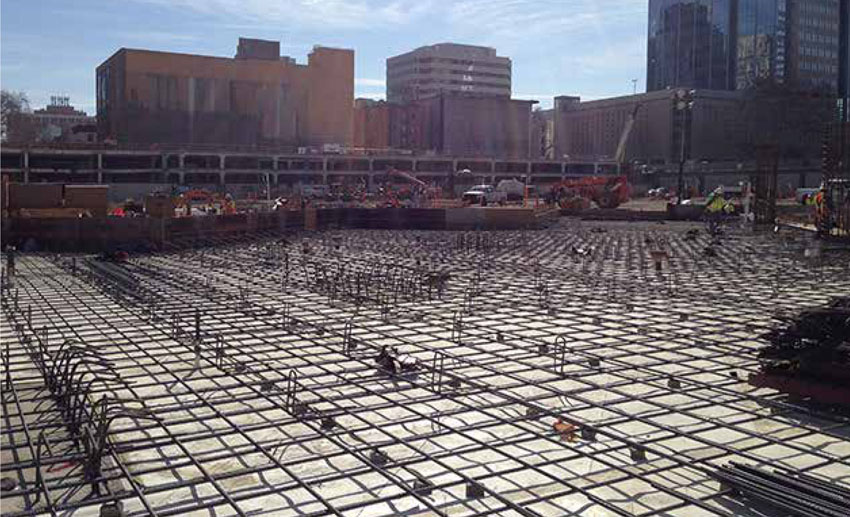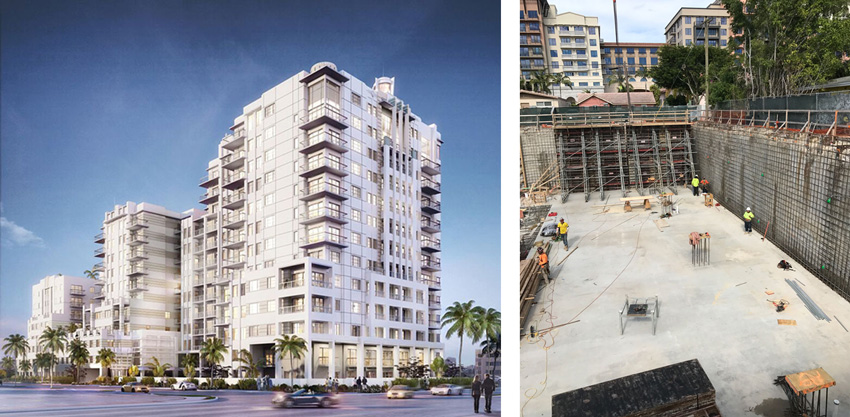Concrete Waterproofing Alternatives
Crystalline Waterproofing
Instead of using a separate membrane, crystalline technology provides concrete waterproofing for new construction by using any or all of the available application methods. A crystalline admixture can be added directly into the concrete mix at the batching plant (preferred) or on-site (for small batches) for most concrete elements. In addition, a slurry mixture can be used to cover joints and seams or untreated concrete and be applied by brush or spray methods. For new concrete slabs or decks, a dry-shake formulation can be troweled into the fresh concrete prior to finishing.
All of these methods provide a continuous waterproof surface across the concrete without any seams. As such, crystalline waterproofing eliminates the need for separate membranes. (Note that a drain tile system along the base of a wall around the perimeter is still recommended). This usually provides significant cost savings compared to the installation of a membrane of any type. Further, it is notably more cost-effective to use integral products (admixture and dry shake) during new concrete construction than an applied coating after the wall is completed.
Some of the characteristics of new construction using crystalline concrete include the following:
- Resistance to extreme hydrostatic pressure: The pressure of water on a concrete wall is what drives many water leaks. Crystalline concrete will resist this effectively whether applied on the positive (exterior) side or the negative (interior) surface of the concrete.
- Integral application: The crystalline treatment becomes a fully integral part of the concrete substrate. It does not require sealing, lapping, and finishing of seams as with membranes. It cannot puncture, tear, or come apart at the seams
- Chemical resistance: Aggressive chemicals found in many subsurface and concrete construction locations are not a problem for crystalline applications since most do not affect the crystalline structures.
- Crack sealing: All concrete will develop some cracking as it cures. Crystalline admixtures can fill and seal static hairline cracks up to 0.4 millimeter wide.
- Human safety: Crystalline applications are nontoxic and contain zero volatile organic compounds (VOCs).
- Cost: It is routinely less costly to incorporate crystalline technology for waterproofing when compared to most other methods.
- Permanence: As noted, the crystalline admixture becomes a permanent part of the concrete that will remain in place for the full lifespan of that concrete.
- Abrasion resistance: Some formulations are available that provide greater resistance to abrasion where required.
- Construction scheduling: As an admixture, crystalline waterproofing is added to the concrete at the time of batching and therefore is not subject to climatic restraints. Further, it does not require protection during backfilling or during placement of steel, wire mesh, or other materials. All of this increases the flexibility in time scheduling and helps projects meet or even beat construction deadlines.
Due to this significant list of properties, crystalline concrete has been used successfully in new construction for commercial buildings, industrial settings, institutional facilities (hospitals, schools, higher education, etc.), multifamily housing, and even high-end single-family homes. All have received the waterproofing and other protective benefits of this technology applied during new construction and realized over the full life of the building.











